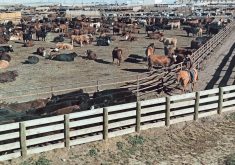The discovery of course material slanted against the feedlot sector prompts broader debate about agricultural education
Alberta off-campus Kindergarten to Grade 12 learning institutes are providing course material on the province’s ranching sector that the head of the provincial cattle feeders’ association is calling deeply problematic.
The course material is circulating in the heart of Alberta’s cattle country, prompting calls for better education and understanding of agriculture.
The material provided to students, and obtained by The Western Producer, links the province’s feedlot alley near Lethbridge to sickness of area residents and death of children.
“Residents in Alberta’s Feedlot Alley have the highest rates of intestinal disease in the province. In a three-year period from 1989 to 1991, E. coli killed almost a dozen children and affected scores more in southern Alberta’s cattle country,” read one section of Modern Agricultural Economies – Animals course material.
Read Also

Huge Black Sea flax crop to provide stiff competition
Russia and Kazakhstan harvested huge flax crops and will be providing stiff competition in China and the EU.
The section also references the Walkerton, Ont., water crisis, which killed seven residents of the region and sickened thousands of others during an E. coli outbreak in 2000.
What’s not mentioned in the course material is that an inquiry into the Walkerton E. coli outbreak blamed inadequate water treatment procedures for the crisis. Nor did it mention that two administrators of that community’s water treatment facility were charged and convicted for their shortcomings in properly treating and monitoring the potable water supply.
Janice Tranberg, Alberta Cattle Feeders’ president, called the material being shared with students “deeply disturbing.”
“Very disappointing that resources are being shared with students that have not gone through rigorous vetting because there are multiple examples of inaccuracies, that with two seconds of review, people could see that they have their information incorrect,” said Tranberg.
When asked about the vetting process for grade-school course material at off-campus learning institutes, Minister of Education Adrianna LaGrange said the department has staff who oversee course resources and determine what is to be authorized and put in the curriculum.
“Beyond that, teachers do have the ability to choose courses themselves and bring them into the classroom,” said LaGrange. “That being said, we want to make sure the information that is taught to our students is the most accurate, most up to date.”
In a statement provided to The Western Producer, the department said Modern Agricultural Economies course material is neither part of provincially developed curriculum nor a provincially developed resource.
“Alberta Education does not currently authorize the resource, Modern Agricultural Economies – Animals. However, school authorities have the autonomy, flexibility and responsibility to make local policy decisions and determine which supports, resources or programs, such as Modern Agricultural Economies – Animals, are most appropriate for their students and school community,” read the statement.
But according to the superintendent of the Strathmore-based Golden Hills Academy of Learning, the course material is from the former government supported Alberta Distance Learning Centre.
Supt. Bevan Daverne said his school has removed the questionable course material from its distance learning classes after being alerted to its contents and that only a very small number of his students were exposed to the inaccurate references to Alberta’s feedlot industry.
“We’ve just eliminated it from the course,” said Daverne, adding it was material ranchers might find offensive and it doesn’t correspond with the reality of how the industry is run today.
The Alberta Distance Learning Centre provided provincial students with correspondence courses for decades before closing after the 2020-21 school year.
“Alberta Distance Learning Centre was funded directly by Alberta Education, by the provincial government, to develop resources and to serve students online and distance learning all across Alberta,” said Daverne. “And they were also funded to share all their resources they developed with every school division all across Alberta.”
Nichole Neubauer spearheaded the development of the Irvine School’s Agriculture Discovery Centre (ADC), which provides hands-on learning to K to Grade 9 students at the public school located east of Medicine Hat.
The material shared with Alberta students in the correspondence course is inherently flawed for no shortage of reasons and stands in direct opposition to what the ADC is trying to achieve, she said.
“When we deal in absolutes, that’s when we set ourselves up to do a disservice to agriculture education,” she said. “What the most important thing an ag educator can do is bring balance to the conversation.”
Providing scientific evidence to back up differing production methods within the ag industry is critical in developing an understanding of the sector and teaching students to think critically.
“You can’t just present something one-sided and expect kids to develop a holistic understanding of the issue,” said Neubauer.
When it comes to teaching students about agriculture in Alberta, Neubauer said she has done informal surveys of teachers to find out how agriculture can be incorporated into lesson plans.
The top responses are they aren’t familiar with modern agricultural practices, they have no connections with the industry and lack resources that can be incorporated into existing teachings.
“We have an amazing opportunity right now in agriculture because the government of Alberta, the education ministry, in their K to 6 curriculum has recently pointed out that Alberta Education will be striving to make increased connections between agriculture and science,” she said. “That is key.”
Tranberg said the demographics of the province have shifted from rural to urban, which has left a disconnect in understanding of the agricultural industry. That means students lack understanding about food production.
“If you ask people where they get their beef, for example, their response would be the grocery store,” said Tranberg. “We’re at a point in time where we do need to bring education on agriculture back into the schools so there is some understanding.”
Georgia Howe, 14, student president of the ADC, said helping her peers without an agricultural background understand the industry is her favorite aspect of the initiative.
“For the board members, it’s pretty much stuff we do in our everyday lives,” she said. “So, it’s really cool for us to get to teach our other classmates about what we are doing at home.”


















